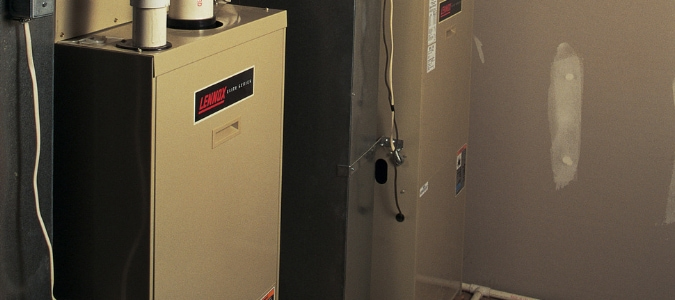
Understanding how HVAC systems work and having an HVAC maintenance checklist can be helpful to avoid potential dangers from these appliances that many of us don’t completely understand nor have the knowledge to repair.
The main cause of carbon monoxide in homes is heating, although chimneys, space heaters, dryers, cars, generators, grills, stoves, ovens and tools can also generate this byproduct. Your heating and cooling system burns fuel to create cool air in the summer and warm air in the winter. Any time fuel is burned, the chemical processes create a byproduct called carbon monoxide, or CO. Cracks and leaks, obstructions and general malfunctions in your heating and cooling system can cause your exhaust system to fail and allow CO to seep into your home. When and if this happens, the consequences can be extremely serious.
Can carbon monoxide leak if a furnace is off? Technically, your system won’t produce carbon monoxide if your furnace is not running. That said, your system can pull in CO from other sources in your home (your water heater or your fireplace, for example) and circulate it throughout your home, especially if you have holes in your air ducts. For that reason, this harmful gas could be distributed through your ducts, even if the leak originates outside of your system.
Therefore, homes with malfunctioning or poorly maintained appliances can put you and your family at greater risk of carbon monoxide inhalation. Many of these tragedies occur when a furnace is on, but problems can also arise when an appliance is off but not properly vented.
Carbon monoxide is a poisonous gas that has no color, odor or taste. This dangerous byproduct is created when any of the following fuels experience incomplete burn:
- Natural gas
- Propane
- Kerosene
- Coal
- Wood
- Oil
CO is so deadly that about 170 people a year die from carbon monoxide poisoning in the United States every year. Each of the 170 deaths is caused by household, non-automotive products and appliances.
How Do I Detect Carbon Monoxide Poisoning?
The initial symptoms of carbon monoxide poisoning are similar to that of a cold, flu or general malaise and may include:
- Headache
- Dizziness
- Nausea
- Fatigue
As poisoning progresses, symptoms will become more severe. Look out for more serious and easy to detect signs of poisoning, including:
- Disorientation
- Vomiting
- Loss of coordination
- Blackouts
Also look for trouble breathing as a warning sign. If you experience any combination of these symptoms, get to an outdoor area for fresh air immediately.
If not treated immediately, these symptoms can lead to death.
Gradual exposure due to exhaust leaks or a malfunctioning HVAC is characterized by milder symptoms that are easily mistaken for minor illnesses.
Don’t take risks. If you begin to feel uncomfortable or sick in your home, have your HVAC system inspected as soon as possible by a trusted professional.
What Can I Do To Prevent Carbon Monoxide Poisoning?
There are a few easy things that a homeowner can do to protect your entire household from the dangers associated with exposure to this gas.
Install A Carbon Monoxide Detector
A carbon monoxide detector that meets the criteria of the current UL 2034 safety standard is a proven and effective tool for poisoning prevention. Install your carbon monoxide alarm in hallways near every possible room. Make sure the alarm receives the proper airflow and isn’t obstructed by furniture. Test your alarm regularly and replace aging batteries.
Have Your HVAC Professionally Installed
Have all of your household appliances installed by qualified technicians, including your HVAC system. Make sure that the installation follows the manufacturer’s instructions and complies with your local building codes. If you’re unsure as to whether your air conditioner was correctly installed, arrange for a technician at a reputable company to conduct an inspection. Have your HVAC serviced annually so it continues to operate as intended.
Leave Maintenance To The Pros
Trying to service appliances that burn fuel without the appropriate knowledge, skills and tools significantly increases the risk of cracks, leaks and malfunctions. Even for minor adjustments to your HVAC, follow all instructions outlined in your owner’s manual and have any protential problems checked out by a professional.
What Should I Do In A Carbon Monoxide Emergency?
You need to get fresh oxygen into your blood as soon as possible to combat the effects of CO poisoning. If you suspect you have been exposed to carbon monoxide, contact your doctor for a diagnosis. Explain your symptoms and explicitly tell your doctor that you suspect carbon monoxide poisoning.
If CO poisoning is confirmed by your doctor, seek medical attention and call a qualified service technician before returning home to take a look at your HVAC.
Never ignore a carbon monoxide alarm that’s sounding. Remember that CO exposure is extremely deadly and that any fuel-burning appliance can cause carbon monoxide to leak into your home. Stay alert and stay safe.
ABC Can Keep You And Your Family Safe
Heating and cooling systems are complex, and risks associated with working with electricity and gas in these components are significant, particularly for the average homeowner without a strong grasp of how these machines operate. The pros at ABC Home & Commercial Services can quickly and effectively handle any issues you may be having with your air conditioner or heater and diagnose and handle any potential issues which can put your family in danger. Avoid the pitfalls and the hassle of attempting to troubleshoot an AC problem by calling in ABC’s experts so that your family can stay comfortable and safe.
